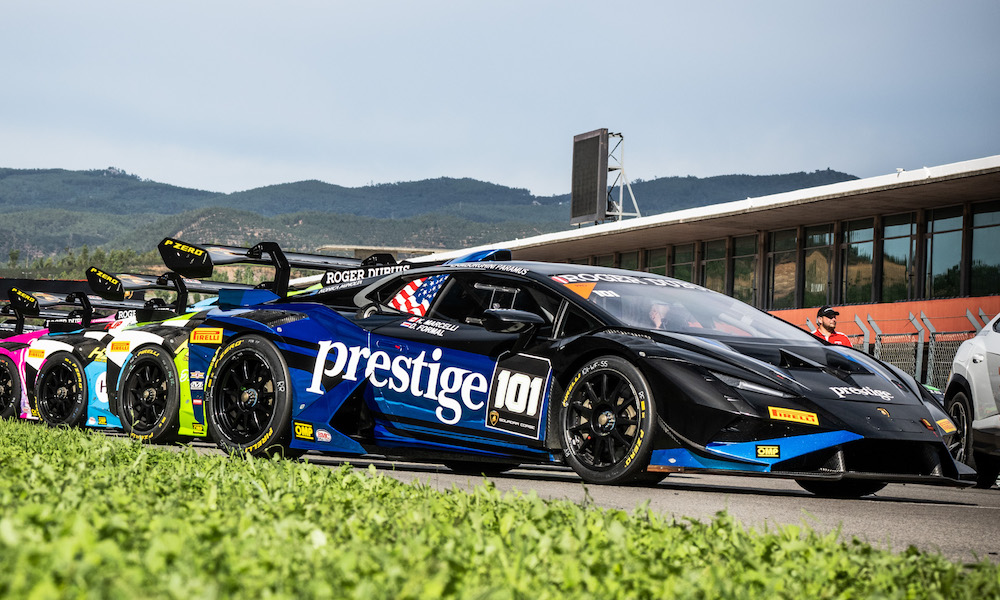
Photo: Eros Maggi/Lamborghini
The transportation of cars and equipment from U.S. teams to Portimao for the Lamborghini Grand Finals was an “extraordinary logistics undertaking” according to Chris Ward, Lamborghini America’s Senior Manager of Motorsport.
Twenty seven cars from teams in the Lamborghini Super Trofeo North America were shipped to Autodromo Internacional do Algarve, with the freight arriving early on Monday morning in time for the first of two days of testing on Tuesday.
Ward explained to Sportscar365 that the relatively tight window between the previous championship round at Virginia International Raceway in mid-August and the end-of-season event in Portugal forced Lamborghini to air-freight all American cars to Europe to get them to the event in time.
“It’s an extraordinary logistics undertaking,” Ward said.
“With the proximity of the last round in the U.S. and then the timing of this Grand Final, the only option was to airfreight everything out here.
“To airfreight with the current global climate of shipping and everything, 27 cars with all the equipment to support those cars is a massive undertaking.
“Our partner at DSV Logistics has done a wonderful job. Everything has arrived safely and in one piece.”
While all cars and equipment were transported via air across the Atlantic, Ward noted that the cars will be shipped back out of Italy on sea freight on return once the event has wrapped up, saying it would have been ‘a bit over the top’ to again opt for air freight for the journey back.
“The cars and equipment will return back to the U.S. by sea with plenty of time for the 2023 championship,” he said.
“It would have been a bit over the top. A bit cost prohibitive. Looking at the logistics calendar everything will be back home and in the teams’ hands ready for the start of the new year.”
Ward gave more detailed insights into the timeframe and challenges involved with the process, explaining that teams were first required to deliver their cars to the logistics hub in Alabama just a few weeks after VIR.
“VIR was in the third week of August,” said Ward. “Teams are obviously spread across the continental U.S., so we give them two to three weeks to prep all the cars and equipment.
“We then give them a date whereby they then have to transport everything to Huntsville.
“Of course, there’s not only the mechanical element of shipping all the cars and equipment but also the legal elements of insurances and the like.
“Paperwork of titles for the cars, fuel cell certificates, roll cage certificates. It just goes on and on, but all of that was accomplished.
“Nothing missed the plane. That was really, really good.”
When asked about the specific choice for Huntsville, Ala, as a departure point, Ward noted: “It’s where our logistics partner [is based]. They have a hub with a charter plane that does a couple of flights a week.
“It leaves out of Huntsville and goes into Luxembourg. Then everything was trucked from Luxembourg down to here.”
Growing Grid Could Impact Future Grand Finals Venue Choice
Ward hinted that the ever-expanding number of cars entered into the Grand Finals could force Lamborghini to think differently when it comes to selecting venues for future editions of the event.
Alongside the North American grid of 27, entries from Super Trofeo Europe combine to form a total entry of 65 cars at Portimao.
Because the American cars were air-freighted, they occupy the pit garages at the Portimao circuit while the European cars are based in the paddock out of their own trucks.
“Obviously our American partners don’t have transporters here, so we have to utilize the garages, which is increasingly proving a challenge, depending on where the Grand Finals are.
“Because fortunately, the series has grown exponentially and this is a record number of cars to bring to the Grand Finals and we are taking up every inch of garage space that we can.”
With Super Trofeo Asia set to return next year after a three-year hiatus, Ward admitted that it a key point of focus for the manufacturer to find a track suitable enough to host the event in 2023, looking at entry numbers.
“Not only the garage space, but also the paddock space for the European teams,” he said. “Then also a suitable track to host that number of cars on track at the same time.”

























